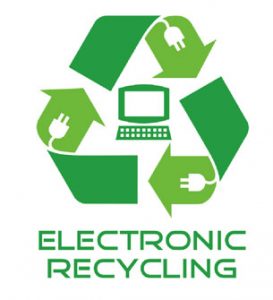A few facts on E-Waste
Not wanting to be accused of plagiarism, we have linked to the facts present in www.earth911.com
The reason that they are amazing is….
- The United States produces more e-waste annually than any other country. The amount of electronics that Americans throw away every year? 9.4 million tons.
- Recycling one million laptops saves the energy equivalent to the electricity used by 3,657 U.S. homes in a year, according to the EPA.
- For every one million cell phones that are recycled, the EPA states that 35,274 lbs of copper, 772 lbs of silver, 75 lbs of gold, and 33 lbs of palladium can be recovered. For those not familiar with palladium, palladium is a precious metal using for making electrical contacts, as well as surgical instruments and parts for watches.
- Only 12.5% of e-waste is recycled, according to the EPA.
- Based on e-waste disposal rates, Americans throw out phones containing over $60 million in gold and/or silver every year.
- Recycling circuit boards can be more valuable than mining for ore! One ton of circuit boards is estimated to contain 40-800 times more gold than one metric ton of ore. There is 30-40 times more copper in a ton of circuit boards that can be mined from one metric ton of ore.
- According to the United Nations, 20-50 million metric tons of e-waste are discarded every year.
- Old television sets as well as CRT (cathode ray tube) monitors contain approximately 4-8 pounds of lead, a neurotoxin. Improper disposal means this toxic substance can leach into the ground.
- It takes 530 lbs of fossil fuel, 48 lbs of chemicals, and 1.5 tons of water to manufacture one computer and monitor, according to the Electronics TakeBack Coalition.
- In 2014, 41.8 million metric tons of e-waste was shipped to developing countries, creating not only a dumping problem in those countries, but also utilizing resources to transport the waste to countries around the world.
- Guiyu, China is a major dumping ground for e-waste from the United States. After the e-waste is transported over to China, the electronics are dumped in the town where it litters the streets and poisons the residents. Hydrochloric acid is thrown on the items to reveal the steel and copper to be reused. High levels of lead have been reported among residents.
- Not all e-waste recyclers are the same. There are safer ways to recycle e-waste, and then there are companies that simply export the waste to developing countries. Rather than monitoring the recycling of the e-waste for health and human safety standards in these developing countries, many businesses simply have residents disassemble waste and use scrap metal, exposing the workers to toxic materials. Look for an e-waste recycling company that has been vetted through e-stewards.org.
- It is estimated that only 29% of global e-waste is handled via the accepted best practice recycling channels.
- Plastics in e-waste can be recycled into garden furniture. Battery components can be reused in other batteries. Metals can be used in jewelry and automotive parts.
- It is estimated that 40% of the heavy metals in U.S. landfills come from discarded electronics, according to Jonas Allen, Director of Marketing for EPEAT, a global green electronic rating system.
- According to Allen, if the recycling rates for gold (15%), silver (15%) and platinum (5%) all increased to 100%, the electronics sector could realize $12 billion in financial and natural capital benefits.
- Approximately 350,000 mobile phones are disposed of each day, according to 2010 figures from the EPA. That equates to more than 152 million phones thrown away in one year.
- There are more mobile phones in existence than there are number of people living on Earth. Based on the number of active SIM cards in use, there are more than 7.2 billion mobile devices being used, while there are less than 7.2 billion people on the planet. The growth rate of mobile devices compared to the population growth rate is five times greater.
- The UN University estimates that global e-waste volumes could increase by as much as 33% between 2013-2017.
Interesting stuff, just the sheer scale of waste in the USA is amazing.
If you are worried about E-Waste and do not have a program to manage or your are looking to revisit your procedures for E-Waste management within your organisation contact Secure Data Recycling for a FREE consultation.


